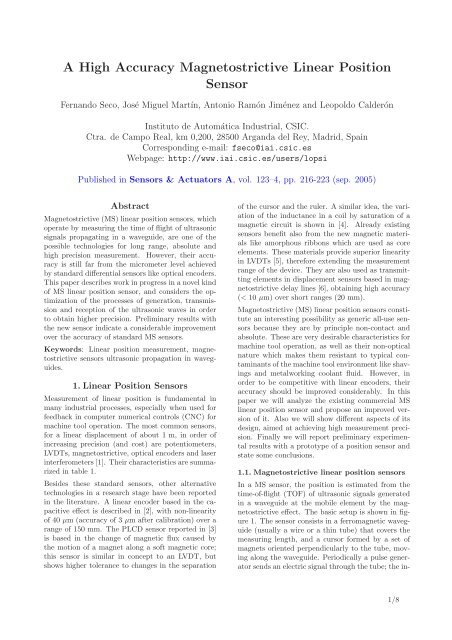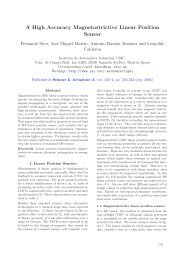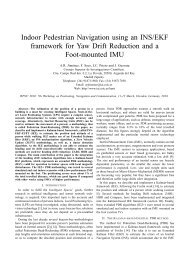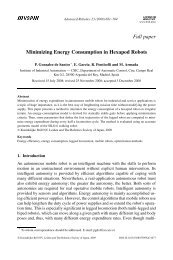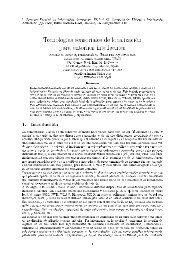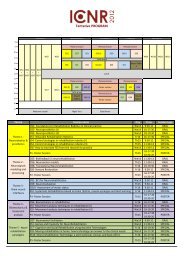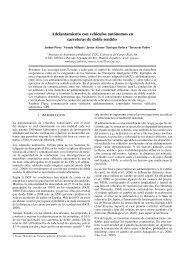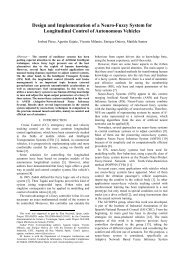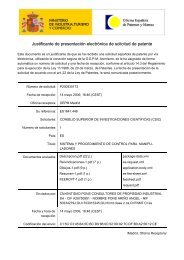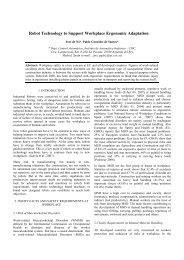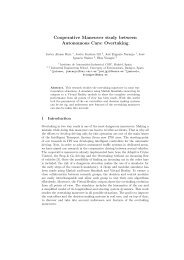Download PDF - Centro de Automática y Robótica
Download PDF - Centro de Automática y Robótica
Download PDF - Centro de Automática y Robótica
Create successful ePaper yourself
Turn your PDF publications into a flip-book with our unique Google optimized e-Paper software.
A High Accuracy Magnetostrictive Linear Position<br />
Sensor<br />
Fernando Seco, José Miguel Martín, Antonio Ramón Jiménez and Leopoldo Cal<strong>de</strong>rón<br />
Instituto <strong>de</strong> <strong>Automática</strong> Industrial, CSIC.<br />
Ctra. <strong>de</strong> Campo Real, km 0,200, 28500 Arganda <strong>de</strong>l Rey, Madrid, Spain<br />
Corresponding e-mail: fseco@iai.csic.es<br />
Webpage: http://www.iai.csic.es/users/lopsi<br />
Published in Sensors & Actuators A, vol. 123–4, pp. 216-223 (sep. 2005)<br />
Abstract<br />
Magnetostrictive (MS) linear position sensors, which<br />
operate by measuring the time of flight of ultrasonic<br />
signals propagating in a wavegui<strong>de</strong>, are one of the<br />
possible technologies for long range, absolute and<br />
high precision measurement. However, their accuracy<br />
is still far from the micrometer level achieved<br />
by standard differential sensors like optical enco<strong>de</strong>rs.<br />
This paper <strong>de</strong>scribes work in progress in a novel kind<br />
of MS linear position sensor, and consi<strong>de</strong>rs the optimization<br />
of the processes of generation, transmission<br />
and reception of the ultrasonic waves in or<strong>de</strong>r<br />
to obtain higher precision. Preliminary results with<br />
the new sensor indicate a consi<strong>de</strong>rable improvement<br />
over the accuracy of standard MS sensors.<br />
Keywords: Linear position measurement, magnetostrictive<br />
sensors ultrasonic propagation in wavegui<strong>de</strong>s.<br />
1. Linear Position Sensors<br />
Measurement of linear position is fundamental in<br />
many industrial processes, especially when used for<br />
feedback in computer numerical controls (CNC) for<br />
machine tool operation. The most common sensors,<br />
for a linear displacement of about 1 m, in or<strong>de</strong>r of<br />
increasing precision (and cost) are potentiometers,<br />
LVDTs, magnetostrictive, optical enco<strong>de</strong>rs and laser<br />
interferometers [1]. Their characteristics are summarized<br />
in table 1.<br />
Besi<strong>de</strong>s these standard sensors, other alternative<br />
technologies in a research stage have been reported<br />
in the literature. A linear enco<strong>de</strong>r based in the capacitive<br />
effect is <strong>de</strong>scribed in [2], with non-linearity<br />
of 40 µm (accuracy of 3 µm after calibration) over a<br />
range of 150 mm. The PLCD sensor reported in [3]<br />
is based in the change of magnetic flux caused by<br />
the motion of a magnet along a soft magnetic core;<br />
this sensor is similar in concept to an LVDT, but<br />
shows higher tolerance to changes in the separation<br />
of the cursor and the ruler. A similar i<strong>de</strong>a, the variation<br />
of the inductance in a coil by saturation of a<br />
magnetic circuit is shown in [4]. Already existing<br />
sensors benefit also from the new magnetic materials<br />
like amorphous ribbons which are used as core<br />
elements. These materials provi<strong>de</strong> superior linearity<br />
in LVDTs [5], therefore extending the measurement<br />
range of the <strong>de</strong>vice. They are also used as transmitting<br />
elements in displacement sensors based in magnetostrictive<br />
<strong>de</strong>lay lines [6], obtaining high accuracy<br />
(< 10 µm) over short ranges (20 mm).<br />
Magnetostrictive (MS) linear position sensors constitute<br />
an interesting possibility as generic all-use sensors<br />
because they are by principle non-contact and<br />
absolute. These are very <strong>de</strong>sirable characteristics for<br />
machine tool operation, as well as their non-optical<br />
nature which makes them resistant to typical contaminants<br />
of the machine tool environment like shavings<br />
and metalworking coolant fluid. However, in<br />
or<strong>de</strong>r to be competitive with linear enco<strong>de</strong>rs, their<br />
accuracy should be improved consi<strong>de</strong>rably. In this<br />
paper we will analyze the existing commercial MS<br />
linear position sensor and propose an improved version<br />
of it. Also we will show different aspects of its<br />
<strong>de</strong>sign, aimed at achieving high measurement precision.<br />
Finally we will report preliminary experimental<br />
results with a prototype of a position sensor and<br />
state some conclusions.<br />
1.1. Magnetostrictive linear position sensors<br />
In a MS sensor, the position is estimated from the<br />
time-of-flight (TOF) of ultrasonic signals generated<br />
in a wavegui<strong>de</strong> at the mobile element by the magnetostrictive<br />
effect. The basic setup is shown in figure<br />
1. The sensor consists in a ferromagnetic wavegui<strong>de</strong><br />
(usually a wire or a thin tube) that covers the<br />
measuring length, and a cursor formed by a set of<br />
magnets oriented perpendicularly to the tube, moving<br />
along the wavegui<strong>de</strong>. Periodically a pulse generator<br />
sends an electric signal through the tube; the in-<br />
1/8
Sensor Meas. range Contact Abs/Inc Precision (µm)<br />
LVDT Small No Abs 250(*)<br />
Potentiometric Medium Yes Abs 400<br />
Magnetostrictive Large No Abs 200<br />
Optical enco<strong>de</strong>r Large No Inc 5<br />
Laser interferometer Very large No Inc 0.1<br />
Table 1: Characteristics of typical commercial linear position sensors: measurement range, contact between the cursor<br />
and the displacement axis, absolute/incremental nature and precision. The precision corresponds to a measuring range<br />
of 1000 mm, except for the LVDT(*), where it is 100 mm.<br />
WAVEGUIDE<br />
RECEIVER<br />
CURSOR<br />
MAGNETS<br />
u<br />
PULSE<br />
GENERATOR<br />
u<br />
DAMPER<br />
Figure 1: Conventional MS linear position sensor.<br />
ur EMITTER ur<br />
RECEIVER 1<br />
uz<br />
uz<br />
WAVEGUIDE RECEIVER 2<br />
v1(t)<br />
z<br />
v0(t)<br />
L<br />
v2(t)<br />
Figure 2: Principle of operation of the Micrus sensor.<br />
teraction of the magnetic field created by the current<br />
with that of the magnets creates a torsional stress<br />
in the wavegui<strong>de</strong> which generates ultrasonic waves<br />
travelling in both directions. One of the waves is<br />
absorbed by a damper, while the other is picked by<br />
the receiver transducer. Measurement of the time of<br />
flight and knowledge of the propagation speed permits<br />
to estimate the cursor position z. The ultrasonic<br />
wave is generated by the Wie<strong>de</strong>mann effect [7]<br />
which is a twist of the wavegui<strong>de</strong> produced by the<br />
interaction of the axial magnetic field with the current<br />
circulating through the wavegui<strong>de</strong>. The stress<br />
in the metal couples to the torsional mo<strong>de</strong>s T(0,m)<br />
of the wavegui<strong>de</strong>, for which the displacement vector<br />
consists of only the azimuthal component (in cylindrical<br />
coordinates, u = [0,u θ ,0] [8]). The ultrasonic<br />
pulse is converted back to an electrical signal through<br />
the inverse magnetostrictive (Villari) effect. The receiver<br />
transducer is a coil encircling a small tape of a<br />
magnetostrictive material placed next to one of the<br />
ends of the wavegui<strong>de</strong>.<br />
2. The Micrus sensor<br />
The proposed MS linear position sensor, which is<br />
named Micrus, follows the working principle illustrated<br />
in figure 2. Although it resembles the conventional<br />
MS sensor, it presents the following innovative<br />
features:<br />
• The position estimation is computed from the<br />
time <strong>de</strong>lay between the ultrasonic signals received<br />
at both ends of the propagating tube.<br />
• The Joule magnetostrictive effect is used to excite<br />
the longitudinal mo<strong>de</strong> L(0,1) of the wavegui<strong>de</strong>,<br />
instead of the torsional mo<strong>de</strong> T(0,1).<br />
• The piezoelectric effect is used for the ultrasonic<br />
signal reception instead of the inverse MS effect.<br />
The next sections cover these characteristics in more<br />
<strong>de</strong>tail.<br />
2.1. Time Delay and Position Estimation<br />
From figure 2, three signals are available for estimation<br />
of the cursor position in the Micrus sensor: the<br />
current in the generating coil, v 0 (t), and the ultrasonic<br />
signals received at the left and right piezoelectric<br />
transducers, v 1 (t) and v 2 (t). It is readily proved<br />
that a linear relationship holds between the cursor<br />
position z and any of three measurable time <strong>de</strong>lays<br />
D ij between signals v i (t) and v j (t).<br />
We have found empirically that the most precise estimation<br />
of the position is obtained by use of the<br />
signals v 1 (t) and v 2 (t). Then, the position can be<br />
estimated as:<br />
ẑ = 1 2 (L − c ̂D 12 ), (1)<br />
where L is the total length of the tube and c the<br />
propagation speed of the ultrasonic mo<strong>de</strong> excited by<br />
the emitter, and ẑ is an estimation of the (actually<br />
unknown) measurand z.<br />
From equation 1, the measurement of position reduces<br />
to a problem of precise time <strong>de</strong>lay estimation<br />
(TDE), which, in our case, can be formulated as [9]:<br />
v 1 (t) = s(t) + η 1 (t)<br />
v 2 (t) = s(t − D 12 ) + η 2 (t),<br />
(2)<br />
where s(t) is the excitation signal in the cursor<br />
coil, and η 1 and η 2 are the respective contaminating<br />
noises, which we will assume to be Gaussian and<br />
uncorrelated to each other and the signals. In these<br />
conditions, it can be proved that the best estimation<br />
2/8
of the time <strong>de</strong>lay ̂D 12 is yiel<strong>de</strong>d by the value that<br />
maximizes the correlation of signals:<br />
∫<br />
̂D 12 = max arg{ ̂R 12 (τ) = v 1 (t)v 2 (t − τ)dt}. (3)<br />
The Cramér-Rao lower bound (CRLB) [10] sets<br />
a limit on the maximum accuracy which can be<br />
achieved in the estimation of the time <strong>de</strong>lay from<br />
the set of equations 2. The standard <strong>de</strong>viation σ D of<br />
the estimation of the <strong>de</strong>lay ̂D is:<br />
σD 2 1<br />
≥<br />
16π 2 BTf0 2 (4)<br />
SNR,<br />
a result which is applicable in the case of narrowband<br />
signals with central frequency f 0 , and spectra contained<br />
in the interval |f| ∈ [f 0 −B,f 0 +B], where the<br />
bandwidth B is small with respect to f 0 . Likewise,<br />
the (linear) SNR must be high enough for unambiguous<br />
<strong>de</strong>termination of the peak of the correlation<br />
R 12 (τ) [11]. The observation time, T, is, in practice,<br />
equal to the duration of the signal s(t).<br />
Another important nuance for the TDE process is<br />
that we will actually work with sampled versions<br />
v 1 [n] = v 1 (nt s ) and v 2 [n] = v 2 (nt s ) of the signals<br />
in equation 2 (t s is the sampling time). If we<br />
limit the precision in the estimation of the correlation<br />
peak to one sampling interval, the error committed<br />
can be as high as ±t s /2. For example, for<br />
a sampling frequency of f s = 2 MHz, and taking<br />
c ≃ 5 µm/ns in equation 1, the position error is<br />
boun<strong>de</strong>d by σ z = 600 µm, which is clearly too high<br />
for a MS sensor.<br />
One method to estimate the time <strong>de</strong>lay D 12 with<br />
subsample precision consists in fitting an analytical<br />
curve to the three samples closest to the discrete<br />
maximum [12] (note that this requires a minimum<br />
sampling frequency f s > 6f 0 in or<strong>de</strong>r to have at least<br />
three points in the positive semi-cycle of the correlation<br />
vector). The proper analytical curve to be fitted<br />
<strong>de</strong>pends on the waveform s(t) used for excitation of<br />
the ultrasonic signals. In the Micrus sensor we have<br />
employed a sine train modulated by a Hanning window:<br />
[<br />
1 − cos( 2πt<br />
T ) ]<br />
[S H (t) − S H (t − T)] sinω 0 t,<br />
s(t) = 1 2<br />
(5)<br />
where S H (t) is Heavisi<strong>de</strong>’s step function, T =<br />
n cyc /f 0 is the total signal length, and n cyc is the<br />
number of cycles of the signal. This waveform does<br />
a good job in producing a finite duration signal with<br />
its energy contained in a small bandwidth.<br />
For the signal of equation 5, the correlation takes a<br />
cosine shape near the peak; thus, an improved estimation<br />
of the <strong>de</strong>lay is obtained by fitting the following<br />
function:<br />
R[m] = acos(bm + c), (6)<br />
to the discrete maximum m max and its neighboring<br />
points. The improved time <strong>de</strong>lay is estimated as:<br />
with:<br />
̂D cos = (m max − c b )t s, (7)<br />
cos b = ̂R[m max − 1] + ̂R[m max + 1]<br />
2 ̂R[m max ]<br />
tan c = ̂R[m max − 1] − ̂R[m max + 1]<br />
2 ̂R[m<br />
.<br />
max ]sin b<br />
2.2. Selection of the propagating mo<strong>de</strong><br />
(8)<br />
A wavegui<strong>de</strong> with cylindrical symmetry can support<br />
three families of mo<strong>de</strong>s: torsional (<strong>de</strong>noted T(0,m)),<br />
longitudinal (L(0,m)) and flexural (F(n,m)) [8]. As<br />
the in<strong>de</strong>x n stands for the or<strong>de</strong>r of symmetry around<br />
the z axis, the torsional and longitudinal mo<strong>de</strong>s are<br />
axisymmetric (n = 0), while the flexural mo<strong>de</strong>s are<br />
asymmetric. The in<strong>de</strong>x m is used to or<strong>de</strong>r the propagating<br />
mo<strong>de</strong>s which can coexist in a family for a<br />
given operating frequency. In general, in any application<br />
which involves ultrasonic waves in solids,<br />
exploitation of a single propagating mo<strong>de</strong> is recommen<strong>de</strong>d<br />
[13].<br />
Ultrasonic signals travelling in a wavegui<strong>de</strong> are subject<br />
to the phenomenon of dispersion, which is the<br />
variation of the phase and group speeds of the propagating<br />
waves with frequency. The theoretical dispersion<br />
curves in the low frequency range for the torsional,<br />
longitudinal and first two families of flexural<br />
mo<strong>de</strong>s are computed with the PCDISP software <strong>de</strong>scribed<br />
in reference [14] and shown in figure 3.<br />
It can be acknowledged from the figure that the mo<strong>de</strong><br />
T(0,1) has the unique feature of being free from dispersive<br />
effects. This is one reason that leads to its<br />
use in the commercial MS sensors that we saw in section<br />
1. In the Micrus sensor, however, we are interested<br />
in exploring the possibilities of using the faster<br />
propagating first longitudinal mo<strong>de</strong> L(0,1) for position<br />
measurement. With a new <strong>de</strong>sign of the emitter<br />
it is possible to obtain high transduction efficiency in<br />
the generation and reception processes, achieving the<br />
SNR required by equation 4 for accurate estimation<br />
of the time <strong>de</strong>lay. For the L(0,1) mo<strong>de</strong>, the displacement<br />
vector has two nonzero entries u = [u r ,0,u z ];<br />
however, at low frequencies, the radial component is<br />
much smaller than the axial one, u r ≪ u z .<br />
One consequence of choosing the mo<strong>de</strong> L(0,1) for operation<br />
of our sensor is that we need to quantify the<br />
effects of dispersion, unlike the case of the torsional<br />
mo<strong>de</strong>. Because the frequency components of the signal<br />
travel at different phase speeds, the signal is distorted<br />
as it propagates along the wavegui<strong>de</strong>. When<br />
those signals are used in the time <strong>de</strong>lay and position<br />
3/8
Phase speed (m/s)<br />
8000<br />
7000<br />
6000<br />
5000<br />
4000<br />
3000<br />
2000<br />
(a)<br />
F(1,1)<br />
F(2,1)<br />
L(0,1)<br />
T(0,1)<br />
F(1,2)<br />
L(0,2)<br />
Error (µm)<br />
2.5<br />
2<br />
1.5<br />
1<br />
0.5<br />
0<br />
−0.5<br />
−1<br />
−1.5<br />
(a) Excitation frequency f 0<br />
f 0<br />
=40 kHz<br />
f 0<br />
=60 kHz<br />
1000<br />
−2<br />
f 0<br />
=80 kHz<br />
0<br />
0 50 100 150 200 250 300<br />
Frequency (kHz)<br />
6000<br />
5000<br />
(b)<br />
L(0,1)<br />
−2.5<br />
0 100 200 300 400 500 600 700 800 900 1000<br />
Position (mm)<br />
3<br />
2<br />
(b) Number of cycles<br />
Group speed (m/s)<br />
4000<br />
3000<br />
2000<br />
F(1,1)<br />
T(0,1)<br />
F(1,2)<br />
L(0,2)<br />
Error (µm)<br />
1<br />
0<br />
−1<br />
1000<br />
F(2,1)<br />
−2<br />
2 cycles<br />
4 cycles<br />
6 cycles<br />
0<br />
0 50 100 150 200 250 300<br />
Frequency (kHz)<br />
Figure 3: (a) Phase and (b) group speed curves for the<br />
torsional T(0,m), longitudinal L(0,m) and first two flexural<br />
mo<strong>de</strong>s, F(1,m) and F(2,m), existing in the frequency<br />
range 0-300 kHz, computed with PCDISP. The tube data<br />
is given in section 3.1.<br />
−3<br />
0 100 200 300 400 500 600 700 800 900 1000<br />
Position (mm)<br />
Figure 4: Simulation of the influence of (a) the central<br />
frequency f 0 (with n cyc = 6); and (b) the number of<br />
cycles n cyc (with f 0 = 60 kHz) of the excitation signal<br />
s(t) on the systematic error in the position estimation.<br />
estimation processes, the result is a systematic (i.e.,<br />
position <strong>de</strong>pen<strong>de</strong>nt) error in the measurement.<br />
Several precautions can be taken to minimize the effects<br />
of dispersion. The width of the flat region of<br />
the L(0,1) curve in figure 3 <strong>de</strong>pends inversely on the<br />
thickness of the tube, so the thinnest available tube<br />
should be used. The excitation signal s(t) should<br />
have a narrow spectral content, and the central frequency<br />
f 0 lie in a point where the dispersion curve<br />
is relatively flat (dc ph /dω ≃ 0).<br />
Where dispersion is unavoidable, theoretical or empirical<br />
knowledge of the wavenumber-frequency relationship,<br />
ξ(ω), can be used to compensate the distortion<br />
suffered by the signal during the propagation in<br />
the wavegui<strong>de</strong>. For example, Gorham and Wu [15]<br />
were able to restore the original shape of stress pulses<br />
caused by impact of steel spheres in pressure bars.<br />
Wilcox [16] has <strong>de</strong>veloped an optimized algorithm<br />
based on use of the FFT which could be employed<br />
for real time correction of dispersive effects.<br />
To check if these methods are really nee<strong>de</strong>d, we performed<br />
simulations of the propagation of signals in<br />
the tube employed in the Micrus system, and the<br />
position estimation method of equation 1, for a total<br />
displacement range of 1 m. Using the software<br />
PCDISP and the method <strong>de</strong>scribed in [17], we studied<br />
the influence of two <strong>de</strong>sign parameters of the<br />
waveform s(t) of equation 5: the central frequency<br />
f 0 and the number of cycles n cyc , on the position<br />
estimation. The results are shown in figure 4 (the<br />
physical data for the transmitting tube is given in<br />
section 3.1. As expected, the position error increases<br />
with frequency, as the dispersion curve of<br />
mo<strong>de</strong> L(0,1) in figure 3 gets steeper and closer to<br />
the cutting frequency of mo<strong>de</strong> L(0,2). The position<br />
error <strong>de</strong>creases with growing signal length (narrower<br />
spectral content), becoming lower than 1 µm<br />
for n cyc > 4 cycles. This is very convenient, because<br />
it allows to use relatively short (temporal or<br />
spatial) excitation signals, and obtain a longer measuring<br />
range for a given tube size.<br />
As a conclusion of the simulation process, active cor-<br />
4/8
STEEL TUBE<br />
PIEZOELECTRIC<br />
CERAMIC<br />
METALLIC<br />
PLATE<br />
V PIEZO<br />
ALUMINUM<br />
ADAPTER<br />
Figure 6: Arrangement of the piezoelectric receiver<br />
transducer at the end of the propagating tube.<br />
30<br />
Figure 5: Magnetostrictive emitter of the Micrus sensor.<br />
rection of the dispersion effects is not nee<strong>de</strong>d for operating<br />
frequencies below 100 kHz, unless the error<br />
due to other sources is inferior to 2 µm.<br />
Gain (dB)<br />
25<br />
20<br />
15<br />
10<br />
2.3. Magnetostrictive Emitter<br />
The emitter transducer of the Micrus system is <strong>de</strong>signed<br />
to produce maximum coupling to the chosen<br />
ultrasonic mo<strong>de</strong> (longitudinal L(0,1)). To this end<br />
the Joule magnetostrictive effect (in which the static<br />
and dynamic fields are arranged in the axial direction<br />
[7]) is used instead of the Wie<strong>de</strong>mann effect.<br />
The emitter transducer, shown in figure 5, consists<br />
mainly of two elements. A set of four Alcomax III<br />
magnets provi<strong>de</strong> a bias field which brings the part<br />
of the tube un<strong>de</strong>r the cursor to a known state in the<br />
magnetization curve, reducing hysteretic effects and<br />
increasing measurement repeatability. In the central<br />
region, an excitation coil (10 mm long, consisting of<br />
60 turns of copper wire), creates the dynamic signal<br />
responsible of the MS generation. The total field is<br />
then given by H(z) = H 0 + H 1 exp j2πf 0 t, with H 1<br />
being about 10 times smaller in magnitu<strong>de</strong> than H 0 ,<br />
in or<strong>de</strong>r to reduce harmonics created by the nonlinear<br />
generation of ultrasound.<br />
Operation with the prototype showed that the position<br />
estimation process suffered from measurement<br />
hysteresis, caused in turn by the magnetic hysteresis<br />
of the metal of the transmitting element. A method<br />
was <strong>de</strong>vised to compensate this problem, by focusing<br />
the dynamic magnetic field and choosing a convenient<br />
material (duplex stainless steel) for the propagating<br />
tube; more <strong>de</strong>tails of this procedure can be<br />
found in reference [18].<br />
2.4. Piezoelectric receiver<br />
We <strong>de</strong>ci<strong>de</strong>d to use the piezoelectric effect instead of<br />
the inverse (Villari) magnetostrictive effect in or<strong>de</strong>r<br />
to enhance the sensitivity of the receivers and in-<br />
5<br />
0<br />
0 50 100 150 200<br />
Frequency (kHz)<br />
Figure 7: Experimental frequency response of the<br />
magnetostrictive-piezoelectric transduction process in<br />
the Micrus system.<br />
crease the SNR for the TDE process (as required by<br />
equation 4). Because there are no mobility requirements<br />
on the receiver transducers, they are simply<br />
stuck at the ends of the tube.<br />
Excellent sensitivity to low frequency (f 0 < 100 kHz)<br />
ultrasonic waves in the tube was obtained with Murata<br />
MA40B8R piezoceramic disks. Each transducer<br />
was attached to the end of the tube with an aluminum<br />
adapter (see figure 6), which served to enhance<br />
the reproducibility of the measurements and<br />
obtain a higher correlation level between signals v 1 (t)<br />
and v 2 (t).<br />
2.5. Selection of excitation frequency (f 0 )<br />
The experimental gain of the whole transducer system<br />
(comprising the processes of magnetostrictive<br />
generation, transmission in the wavegui<strong>de</strong> and piezoelectric<br />
reception) is shown in figure 7. The response<br />
of the system is contained mainly in the 20-140 kHz<br />
range, achieving the maximum gain at 80 kHz, and<br />
with a second peak at a very low frequency (25 kHz).<br />
This second maximum corresponds to a resonance of<br />
the adapter piece.<br />
Besi<strong>de</strong>s high gain, it is also <strong>de</strong>sirable to obtain high<br />
correlation between the emitted and received signals,<br />
5/8
6<br />
4<br />
2<br />
0<br />
−2<br />
−4<br />
f 0<br />
=60 kHz<br />
R=0.969<br />
f 0<br />
=70 kHz<br />
R=0.923<br />
f 0<br />
=80 kHz<br />
R=0.959<br />
f 0<br />
=90 kHz<br />
R=0.881<br />
f 0<br />
=100 kHz<br />
R=0.901<br />
−6<br />
50 100 150 200 250 300 350<br />
Time (µs)<br />
Figure 8: Emitted (light line) and received (dark line)<br />
signals for different excitation frequencies f 0 (signals have<br />
been normalized to unit amplitu<strong>de</strong>), and values of their<br />
cross correlation.<br />
for optimal results of the correlation algorithm. An<br />
excitation frequency close to the maximum amplitu<strong>de</strong><br />
point (80 kHz) causes signal ringing and <strong>de</strong>teriorates<br />
the correlation value. Experimental waveforms<br />
for different values of the frequency f 0 along with the<br />
normalized correlation, are shown in figure 8, where<br />
the excitation waveform is given by equation 5 with<br />
n cyc = 8.<br />
With help of the data in this figure we finally selected<br />
the excitation frequency for Micrus as f 0 = 60 kHz.<br />
Lower frequencies, which empirically provi<strong>de</strong> even<br />
higher correlation values, were avoi<strong>de</strong>d to keep the<br />
signal length down.<br />
3. Empirical results<br />
In this part we will <strong>de</strong>scribe the physical prototype in<br />
which we implemented the techniques of the last section<br />
and provi<strong>de</strong> some experimental measurements<br />
obtained with the sensor.<br />
3.1. Micrus prototype<br />
The Micrus linear position sensor is shown in figure 9.<br />
The excitation signal (equation 5) is created in the<br />
central PC and transmitted via the GPIB bus to an<br />
arbitrary waveform generator (Agilent 33120A), filtered<br />
by an RC filter to smooth out the quantization<br />
steps of the 8-bit signal generator, amplified by a<br />
driver (ENI mo<strong>de</strong>l 240L, with a gain of 50 dB) and<br />
put into the emitter coil. The current through this<br />
coil (signal v 0 (t) in figure 2) is measured with a 0.1 Ω<br />
sensing resistance in series.<br />
The transmitting wavegui<strong>de</strong> is a stainless duplex<br />
steel tube (Sandvik SAF2304), with outer diameter<br />
8 mm and thickness of 1 mm, and a total length of<br />
1600 mm. The measurable range is 1000 mm, because<br />
a guard distance at both si<strong>de</strong>s must be left<br />
to avoid interference of the emitted signals and the<br />
echoes from the extremes of the tube. This is known<br />
to be a limiting factor of the accuracy obtainable<br />
with magnetostrictive sensors [19]. The speed of<br />
sound of the L(0,1) mo<strong>de</strong> at 60 kHz is very close<br />
to the bar velocity, c 0 = 5060 m/s. The tube is fixed<br />
to an optical bench (Newport X95-2), and held by<br />
silicon supports to avoid mechanical loading of the<br />
propagating ultrasonic waves. A commercial optical<br />
enco<strong>de</strong>r (Fagor Automation mo<strong>de</strong>l CX 1545, with<br />
range of 1.5 m and rated accuracy ±5 µm) is installed<br />
on the same frame for calibration and measurement<br />
of error purposes. The measurement is displayed<br />
in a digital readout and transmitted to the<br />
control PC through the serial port.<br />
After reception of the propagating ultrasonic signals<br />
by the piezoceramics, they are amplified by instrumentation<br />
amplifiers, and isolated and <strong>de</strong>coupled<br />
with pulse transformers to achieve a high common<br />
mo<strong>de</strong> rejection ratio. The three signals v 0 (t), v 1 (t)<br />
and v 2 (t) are simultaneously digitized with an acquisition<br />
card (Adlink PCI-9812), with a sampling frequency<br />
ranging between 1 and 5 MHz. The PC processes<br />
the acquired signals with an IIR Butterworth<br />
lowpass digital filter, with the cutoff frequency set at<br />
2f 0 , in or<strong>de</strong>r to reject the out of band and quantization<br />
noise, and improve the SNR. The PC also runs<br />
the time <strong>de</strong>lay and position estimation algorithms<br />
and provi<strong>de</strong>s a graphical interface and data analysis<br />
capabilities.<br />
The experimental prototype of the Micrus sensor just<br />
<strong>de</strong>scribed was created with flexibility in mind, in or<strong>de</strong>r<br />
to permit modifications during its <strong>de</strong>velopment.<br />
For this reason, standard laboratory equipment and<br />
a common PC have been used in its <strong>de</strong>sign. In a preindustrial<br />
version a suitable DSP would substitute<br />
the PC, the function generator and the acquisition<br />
card used in the creation, reception and processing of<br />
the ultrasonic signals; with custom electronic drivers<br />
and amplifiers being incorporated into the sensor.<br />
The final cost of the sensor could be consi<strong>de</strong>rably<br />
cheaper than that of a quality optical enco<strong>de</strong>r, since<br />
no expensive element like a glass substrate with the<br />
grating is nee<strong>de</strong>d.<br />
6/8
OPTICAL ENCODER<br />
RECEIVER 1<br />
DRIVER<br />
EMITTER<br />
I I<br />
IIIII<br />
IIIIIII I<br />
IIII<br />
IIIII<br />
CURSOR<br />
WAVEGUIDE<br />
SIGNAL<br />
GENERATOR<br />
RECEIVER 2<br />
V1(t) V0(t) SYNCHRONIZATION<br />
V2(t)<br />
GPIB<br />
BUS<br />
ACQUISITION<br />
CARD<br />
SERIAL<br />
PORT<br />
DIGITAL READOUT<br />
X 23.475<br />
Y 0.110<br />
Z -102.240<br />
Figure 9: Block diagram of the prototype of the Micrus sensor.<br />
Sampling frequency,<br />
Time <strong>de</strong>lay Position er-<br />
f s (MHz) error, σ D (ns) ror, σ z (µm)<br />
1 14.4 36<br />
2 3.4 8.5<br />
5 1.4 3.5<br />
Table 2: Standard <strong>de</strong>viation of the estimation of time<br />
<strong>de</strong>lay and position in the Micrus system, with respect to<br />
the sampling frequency.<br />
Error (µm)<br />
40<br />
30<br />
20<br />
10<br />
0<br />
−10<br />
−20<br />
3.2. Position measurement<br />
A first experiment was performed to obtain empirical<br />
data of the variation of the time <strong>de</strong>lay with the<br />
sampling frequency (f s ), recor<strong>de</strong>d at a static position<br />
of the cursor close to the middle of the measuring<br />
range. Results for three sampling frequencies<br />
are shown in table 2. Oversampling the signals with<br />
f s ≫ f 0 is advantageous because it is equivalent in<br />
practice to increasing the SNR, and therefore, reducing<br />
the standard <strong>de</strong>viation of the TDE process,<br />
according to equation 4. Setting the sampling frequency<br />
as f s = 2 MHz, we obtain a dispersion in the<br />
measurements of 3.4 ns, which means that the precision<br />
of the sensor can be taken as 8 µm. However,<br />
the position repeatability, i.e., the difference of the<br />
measured values when the same reference position is<br />
reached several times, is higher, typically equal to<br />
10 µm. This is a value twice as large of that of the<br />
optical enco<strong>de</strong>r used for reference.<br />
The dynamic behavior of the sensor was obtained by<br />
moving the cursor in several cycles that covered the<br />
whole displacement range (1000 mm), recording the<br />
position estimation of Micrus and the measurement<br />
of the reference optical enco<strong>de</strong>r. The difference between<br />
them, ẑ[Micrus] − ẑ[enco<strong>de</strong>r] is graphed as an<br />
−30<br />
−40<br />
0 200 400 600 800 1000<br />
Position (mm)<br />
Figure 10: Typical error curve of the Micrus sensor,<br />
computed as the difference between the position estimation<br />
and the commercial optical enco<strong>de</strong>r output. Three<br />
cycles over the whole measuring range are shown.<br />
error curve in figure 10. The nonlinearity is boun<strong>de</strong>d<br />
by ±30 µm in the whole range of the sensor. While<br />
this is still too high for machine tool operation, the<br />
precision is about 6 times better than that of conventional<br />
magnetostrictive linear position sensors (<strong>de</strong>scribed<br />
in section 1.1). The error pattern is quite<br />
repetitive, and characteristic of the tube used; we<br />
believe that it ultimately corresponds to the mechanical<br />
and magnetic inhomogeneities of the tube that<br />
serves as propagating medium for the ultrasonic signal.<br />
One important aspect of the operation of the Micrus<br />
sensor which needs to be commented is the influence<br />
of temperature on the position measurement. In optical<br />
enco<strong>de</strong>rs, the main effect is the expansion of the<br />
substrate material, which for glass is typically about<br />
7/8
10 −5 o C −1 . The thermal behavior of the substrate is<br />
well known, to the point that some enco<strong>de</strong>r manufacturers<br />
offer products with expansion characteristics<br />
which match those of the machine tool in which they<br />
will be used. In magnetostrictive sensors, the most<br />
influential factor is rather the change of the propagation<br />
speed of the ultrasonic wave (in the or<strong>de</strong>r of<br />
10 −4 o C −1 for steel). In the laboratory experiment<br />
of figure 10, the temperature was kept constant at<br />
25 ± 0.25 o C. For operation in realistic machine-tool<br />
environments, some method of active temperature<br />
compensation should be inclu<strong>de</strong>d (for example, integrating<br />
a temperature sensor in Micrus).<br />
4. Conclusions<br />
In this paper we have proposed a novel <strong>de</strong>sign of a<br />
magnetostrictive (MS) linear position sensor, which<br />
differs in several aspects from the existing sensors,<br />
and is inten<strong>de</strong>d to provi<strong>de</strong> higher accuracy. The<br />
modifications inclu<strong>de</strong> the measurement principle, the<br />
propagating mo<strong>de</strong> selected and the receiver transducer.<br />
The results with a prototype MS linear position sensor<br />
(Micrus) built according to those principles have<br />
shown an accuracy of ±30 µm over a 1 m range, significantly<br />
improving the performance of existing sensors.<br />
We believe that the precision is ultimately limited<br />
by the mechanical and magnetic homogeneity of the<br />
tube which serves as the propagating element of the<br />
ultrasonic signals. The regularity of the obtained<br />
error pattern suggests that further improvements of<br />
the position sensor are possible and that the precision<br />
of MS linear position sensors may come closer<br />
to that of optical enco<strong>de</strong>rs.<br />
References<br />
[1] J. G. Webster (Ed.), The Measurement, Instrumentation<br />
and Sensors Handbook, The Electrical<br />
Engineering Handbook Series, CRC Press,<br />
Springer and IEEE Press, 1999.<br />
[2] M. H. W. Bonse, F. Zhu, H. F. van Beek, A<br />
long-range capacitive displacement sensor having<br />
micrometre resolution, Meas. Sci. Technol.<br />
4 (8) (1993) 801–807.<br />
[3] O. Erb, G. Hinz, N. Preusse, PLCD, a novel<br />
magnetic displacement sensor, Sensors and Actuators<br />
A 25-27 (1991) 277–282.<br />
[4] B. Legrand, Y. Dor<strong>de</strong>t, J.-Y. Voyant, J.-P. Yonnet,<br />
Contactless position sensor using magnetic<br />
saturation, Sensors and Actuators A 106 (1-3)<br />
(2003) 149–154.<br />
[5] T. Meydan, G. W. Healey, Linear variable differential<br />
transformer (LVDT): linear displacement<br />
transducer utilizing ferromagnetic amorphous<br />
metallic glass ribbons, Sensors and Actuators<br />
A 32 (1992) 582–587.<br />
[6] V. Karagiannis, C. Manassis, D. Bargiotas, Position<br />
sensors based on the <strong>de</strong>lay line principle,<br />
Sensors and Actuators A 106 (1-3) (2003) 183–<br />
186.<br />
[7] E. du Trémolet <strong>de</strong> Lacheisserie, Magnetostriction:<br />
Theory and applications of magnetoelasticity,<br />
CRC Press, 1993.<br />
[8] D. C. Gazis, Three-dimensional investigation<br />
of the propagation of waves in hollow circular<br />
cylin<strong>de</strong>rs. I. Analytical foundation. II. Numerical<br />
results., J. Acoust. Soc. Am. 31 (5) (1959)<br />
568–578.<br />
[9] G. C. Carter, Coherence and time <strong>de</strong>lay estimation,<br />
Proceedings of the IEEE 75 (2) (1987)<br />
236–255.<br />
[10] J. Minkoff, Signals, Noise and Active Sensors,<br />
1st Edition, Wiley Interscience, 1992.<br />
[11] A. Zeira, P. M. Schultheiss, Realizable lower<br />
bounds for time <strong>de</strong>lay estimation: Part 2 -<br />
Threshold phenomena, IEEE Trans. on Signal<br />
Processing 42 (5) (1994) 1001–1007.<br />
[12] I. Céspe<strong>de</strong>s, Y. Huang, J. Ophir, S. Spratt,<br />
Methods for estimation of subsample time <strong>de</strong>lays<br />
of digitized echo signals, Ultrasonic Imaging<br />
17 (2) (1995) 142–171.<br />
[13] J. L. Rose, Ultrasonic Waves in Solid Media, 1st<br />
Edition, Cambridge University Press, 1999.<br />
[14] F. Seco, J. M. Martín, A. R. Jiménez, J. L. Pons,<br />
L. Cal<strong>de</strong>rón, R. Ceres, PCDISP: a tool for the<br />
simulation of wave propagation in cylindrical<br />
wavegui<strong>de</strong>s, in: 9th International Congress on<br />
Sound and Vibration, Orlando, Florida, USA,<br />
July 8-11, 2002, p. 23.<br />
[15] D. A. Gorham, X. J. Wu, An empirical method<br />
for correcting dispersion in pressure bar measurements<br />
of impact stress, Meas. Sci. Technol.<br />
7 (9) (1996) 1227–1232.<br />
[16] P. D. Wilcox, A rapid signal processing technique<br />
to remove the effect of dispersion from<br />
gui<strong>de</strong>d wave signals, IEEE Transactions on Ultrasonics,<br />
Ferroelectrics and Frequency Control<br />
50 (4) (2003) 419–427.<br />
[17] J. F. Doyle, Wave Propagation in Structures,<br />
2nd Edition, Springer, 1997.<br />
[18] F. Seco, J. M. Martín, J. L. Pons, A. R. Jiménez,<br />
Hysteresis compensation in a magnetostrictive<br />
linear position sensor, Sensors and Actuators A<br />
110 (1-3) (2004) 247–253.<br />
[19] A. Affanni, A. Guerra, L. Dallagiovanna,<br />
G. Chiorboli, Design and characterization of<br />
magnetostrictive linear displacement sensors, in:<br />
Instrumentation and Measurement Technology<br />
Conference, IMTC 2004, Como, Italy, May 18-<br />
20, 2004, pp. 206–209.<br />
8/8


